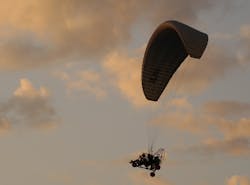Ultralight and light aircrafts and their robust application scope in recreational aviation activities
SELBYVILLE, Del., - Growing flight operation ease coupled with the rising propensity of individuals in partaking in off-beat recreational activities is giving a significant boost to the thriving general aviation industry. Studies suggest that nearly 25,212,000 general aviation flight hours are recorded per year.
This growing indulgence in aero-based recreational activities is leading to a prolific rise in demand for suitable aircrafts, most notably ultralight and light aircrafts.
Global ultralight and light aircraft market growth is considerably bolstered by the product’s robust application scope across myriad aero-sports and recreational activities including hobby flying, air racing, stunting, drone sport, glide, jump and paragliding, among others.
What is an ultralight aircraft?
The experience of flying ultralight aircrafts, also known as microlight aircrafts, has been described as riding a motorcycle in the sky. Ultralight planes are lightweight aircrafts with fixed-wing and have a capacity of one to two people. These aircrafts are designed especially for recreational usage and short-distance flying. The features of these ultralight and light aircrafts, their speed limit and weight vary according to the requirements of different regions. Aviation authorities across different nations have distinct standards and definitions of slow-flying lightweight aircrafts, which are subject to various regulations.
The Federal Aviation Regulations’ Part 103, established in 1982 by the FAA, has set forth guidelines for the use of ultralight airplanes. These aircrafts are described as single-seat vehicles, with a maximum empty weight capacity of less than 254 lbs. Two-seat ultralight planes are considered as LSAs (light sport aircrafts). Maximum air speed of these vehicles cannot exceed 55 knots, while stall speed cannot cross 24 knots.
Part 103 also states that the aircraft does not require a certification or registration for airworthiness. Furthermore, it also states that the ultralight plane operators are not obligated to meet any criteria pertaining to aeronautical knowledge, experience, age, etc., or to have any medical or airman certificates to operate these vehicles. However, the authority does recommend an FAA-approved training course to be undertaken prior to commencing operation.
Lift Aircraft, a start up by uShip online shipping marketplace creator Matt Chasen is working towards offering ultralight aircrafts that can be operated even by laymen. The firm is aiming at selling rides on an electrically powered light aircraft that can be easily operated even by tourists for short leisure rides.
Hexa by Lift is an electric, vertical-takeoff-and-landing aircraft also known as an eVTOL aircraft, which is designed to be rented out for 8-15-minute scenic flights in uncongested areas near tourist destinations, entertainment hubs and key metro locations. The 430-pound, 18-propeller, one-seater Hexa qualifies as a “powered ultralight” aircraft under the rules laid down by the FAA, meaning that there is no requirement of a pilot’s license to operate the vehicle.
Emergence of electric-powered ultralight and light aircrafts amid burgeoning climate change concerns
Aviation is one of the most integral contributors to the development of the global economy. Unfortunately, however, aviation is also responsible for nearly 2% of CO2 emissions across the globe. Furthermore, particulates and nitrogen oxides emitted by aircrafts at cruising altitudes also impart a warming effect on the environment, which further adds to adversities in climate conditions.
This issue can be mitigated however, as similar to electric cars, electrically powered aircrafts are also demonstrating significant potential in ensuring sustainable, emission-free aircraft operation. These novel aircraft technologies also pave the way for a host of new airplane designs and air transport business models.
To illustrate, aircraft manufacturer Pipistrel, in 2016, developed a prototype for an electrically powered microlight aircraft, weighing just 300 kg. This plane, dubbed Alpha Electro, is the first serially produced ultralight aircraft powered by an electric motor in the world.
The airplane’s 300 kg weight includes the 21kWh battery, which weighs 100kg. The two-seat ultralight aircraft offers an hour of flight time and is able to cover nearly 160 kilometers. Moreover, the plane can be charged in roughly one hour.
While the technology is still in nascent stages, researchers and experts, including ultralight and light aircraft industry players, are working towards developing electric airplanes that will transform the aviation landscape in coming years.
For a deeper look at industry trends in the ultra- and light aircraft market, please click here to visit Global Market Insights report on the subject.
